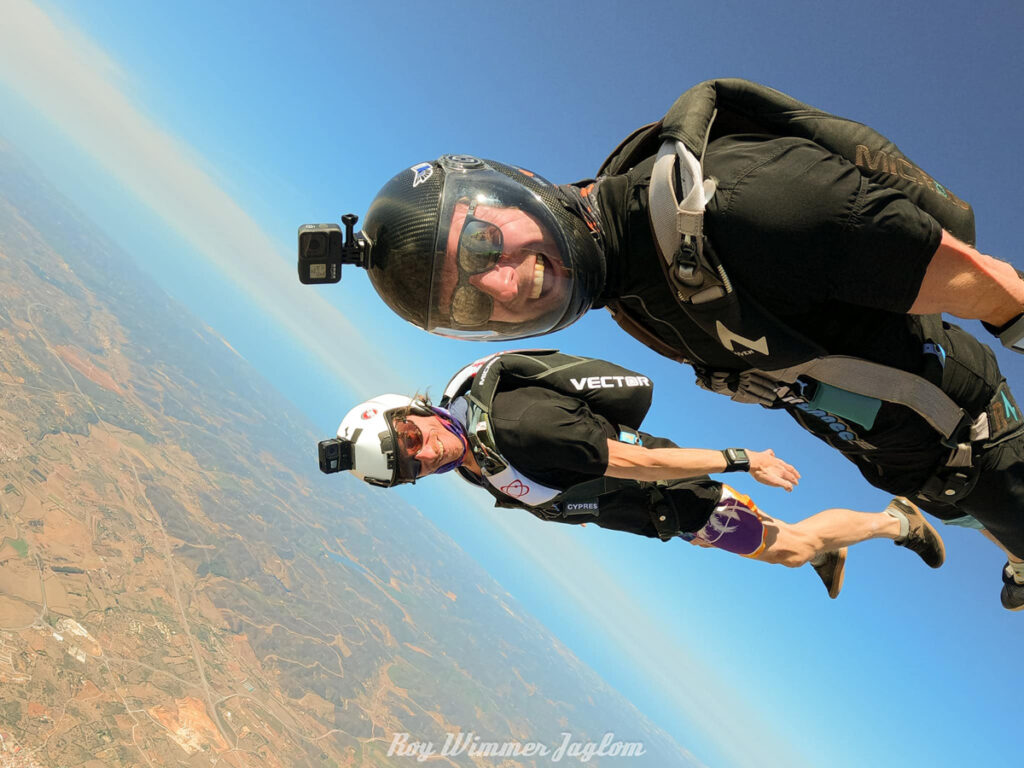
Photo: Tim Douglas and Jasper van der Mere by Roy Wimmer Jaglom
Ralph Wilhelm takes a closer look at wearing glasses for skydiving…
There are five reasons for a skydiver to wear glasses.
- Eye protection from the wind with an open-face helmet
- Correction of a sight debility
- Sun protection
- Impact protection
- …and looking cool!
No matter what your reason is, make sure you choose the right glasses, to be comfortable, effective and compatible. Treat your glasses as an essential part of your gear – because they are. Make the right choice, aiming to find a good balance between comfort, safety & style. Here’s some food for thought and some words of experience…
Oldie

1 Wind Protection
When using an open-face helmet, the shape of the glasses, which dictates the fit, is most important. The less wind you get into your eyes, the lower the risk of temporarily losing vision, due to your eyes watering. If a newbie skydiver asks which glasses to buy, people often answer with brand names. That does not really help. Every face has a different form. It’s paramount that the shape of the glasses fits the shape of your face as well as possible. Too much space between the frame and your face makes it far too windy. It might look cool but these glasses are not suitable for skydiving.
So, I went around the DZ and asked everybody who was wearing glasses to let me try their brands. Trying the glasses of another instructor (thanks Jeanine), I found that WileyX fit my face perfectly. However, they might not fit your face at all. Most manufacturers have different models for longer or rounder shaped faces. You have to try them on.
Fit

The thickness of the glasses at the temples is quite important. Thick temples are a pain (in the face) when you put the glasses on while wearing a full-face helmet, and can cause discomfort and pain when wearing an open-face helmet, as the temples are pressed against your skin/skull by the helmet. Remember you might sit quite a time with your helmet on during the way to altitude and on the way down under canopy. It sounds a bit unusual, but bring your helmet if you try out any glasses for fit. They might fight perfectly without the helmet but may be hard to get on when wearing a full-face helmet or may cause discomfort when wearing them under the helmet for a longer time.
Shapes

Photo by Ralph Wilhelm

Trying your glasses on with your helmet is absolutely imperative since the temples are usually thicker and the pressure against the skull might become unbearable after several minutes. I accidentally wore corrective sunglasses for the first time with my G3 full face, as I forgot to swap to my normal eye-wear on a sunny day. I had no other choice but to endure massive discomfort throughout the jump. Taking them off would have meant seeing close to nothing beyond several meters which was clearly not an option.
Oksana Golubtsova
4-way and big-way jumper
Thin temples

Another nice-to-have point if you are using an open-face helmet is if the glasses are set up for use with a neckband. Since you don’t want to lose your glasses in freefall, the use of a neckband is strongly recommended. Some brands depend on aftermarket slip-over neckbands. I don’t like this solution, as these neckbands are not so easy to install or remove, and I don’t need a neckband when driving a car or just doing something different than skydiving on a sunny day (what a strange thought!). I prefer glasses where the temples are set up in a way that you can snap a neckband on and off in no time.
Neckband options

With some glasses you can quickly change from a neckband to temple. 
Try the glasses you want to buy with the neckband. They may have holes to attach the neckband in different places which may sit a little uncomfortably under the rim of the helmet. 
Some types of neckband keep your glasses hanging around your neck on a long setting while sitting firm on your face when tightening the neckband. 
An inexpensive rubber band will hold your glasses in place, but it can’t be removed quickly if you wear your glasses for a non-skydiving activity.
Photos by Ralph Wilhelm
If you have very wind-sensitive eyes, if your contact lenses are easily dislocated by the wind or if none of the glasses you tried really fits you, a gasket is the perfect solution. This is a foam frame you can clip on your glasses, sometimes it’s called a facial seal. Depending on the jump I do, I sometimes additionally clip it on the glasses, with a well-designed pair of glasses this is done in about 5 seconds. So make sure that the glasses of your choice offer this option.
Gaskets

A facial seal or gasket is a clip-on foam frame that closes the gap between your face and your glasses. When you wear contact lenses or have wind-sensitive eyes, this is a good, fast add-on 
The gasket closes any gap between the face and the glasses and sits comfortably due to the soft foam 
Make sure the gasket can easily be installed and removed
Photos by Ralph Wilhelm
2 Sight Correction
How about corrective lenses? If you have a sight debility (amblyopia) and don’t want to wear contact lenses, you should check if the pair of glasses you want can have corrective lenses installed. Or, does it have the possibility to clip another small frame with corrective lenses on the inside of the glasses?

I have a pretty strong prescription, and my eyes have become sensitive to contact lenses over the years, so these are no longer an option for me. This means I have to find sunglasses in which it is possible to accommodate my prescription. I find that the glasses which fit best and block out the wind are generally ‘wraparound’ ones with very curved lenses, but unfortunately the curved lenses are very difficult and/or expensive to make with a high prescription lens. The solution I have found is to search for glasses which do not have extremely curved lenses, but instead keep the wind out by using a buil- in windshield on the gaps between the face and the glasses, which blocks the wind from hitting the eyes. The model I use at the moment is the Shield by Julbo.
Ewan Cowie
5,000 Jumps
Freefly videographer
Corrective lenses

With some glasses you can have a second frame which is carrying the corrective lenses as a clip on. 
For different situations, different lens colors are helpful. You don’t want to do a night jump with tinted glasses. So changeable lenses might be an option.
Photos by Ralph Wilhelm
3 Sun Protection
Make sure that glasses do NOT have polarized lenses. The sky looks better with them, but all the gauges in the cockpit and most digital altimeters on your wrist are hard or impossible to read with polarized lenses.
Bear in mind that flying formations requires a lot of eye contact. Having the eyes hidden behind mirrored sunglasses risks killing mutual communication. Some organisers discourage wearing such type of sunglasses and you won’t spot any high-level teams wearing them. It’s wise to choose sunglasses that still allow your eyes to be seen.

I have been using the WileyX XL-1 Advanced “sunglasses” for years. In addition to the dark sunglass lenses, the glasses also have yellow and untinted lenses. I like to use the yellow lenses in the evening or when the sky is overcast. I also use the yellow lenses when jumping with students, as my eyes can be seen then as well. Changing the lenses is a bit of fiddling, but no problem. In addition, you can still insert a gasket, whereby the glasses around the eyes completely sealed. In my experience, however, this is not necessary.
Max Österling, Germany
1.100 + jumps
Instructor and large formation videographer
Ventilation open / Ventilation closed
Depending on your non-skydiving activity as well as on the position of your face towards the wind in freefall, a ventilation system might be an option. The Wiley X Ozone offers such a system that can be open and closed with one click.

Ventilation Open 
Ventilation closed
Photos by Ralph Wilhelm
4 Impact protection
Finally yet importantly, I prefer the lenses to be impact-rated. While flying camera above bigways, I had a lot of near-misses with even things like hook knives and metal handles. No matter if you do freefly or belly, sooner or later you will get somebody’s foot or knee in your face. A cheap pair of lenses – plastic or glass – might shatter. And for sure the last thing you want to have directly of front of your eyes are broken pieces of glass. So, I only wear glasses which are impact-rated according to EN.166 or ANSI Z87.1. These glasses can also be used at the shooting range.
Impact


For me, the most important thing about skydiving goggles is that they are as tight as possible, since I wear contact lenses. Nevertheless, they must not fog up. As a videographer, there is nothing worse for me than not being able to see what I am filming because of driving wind or haze obscuring my view. The formation is a short distance below me, so good visibility is elementary to get good shots and also safety relevant, because I don’t want to get burbled and fall onto the formation below me.
“Another important criterion is that the glasses must not move when I wear them under the helmet. The helmet is very tight and when I put it on, the goggle strap on the back of my head must stay in place. There’s an aiming mark on the lens that shows me exactly where I’m filming, so the glasses have to stay in the same position on my face, but they shouldn’t be so tight that they hurt. They should therefore be well padded. It’s also important that the lenses are as scratch-resistant as possible and do not shatter in the event of a collision. As a videographer, you’re in a very exposed position – at the exit – so it can happen that you get a hand or a shoe in your face.
Virginie Seyler, France
2,200+ jumps
videographer for tandem, 4way and large formation
5 Looking Cool
But very last and for sure least, always remember the first rule – always look cool!

Photo: Morven Thompson by Roy Wimmer Jaglom

